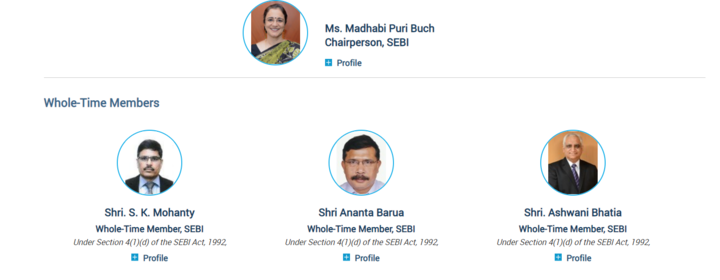- Home/
- Regulatory Bodies/
- SEBI Grade A/
- Article
Securities and Exchange Board of India (SEBI): Role, HQ, Chairman, Functions & Power
By BYJU'S Exam Prep
Updated on: September 11th, 2023

Securities and Exchange Board of India (SEBI): SEBI is one of the statutory regulatory bodies of India. SEBI mainly monitors and regulates the securities market and promotes and protects the interests of investors by enforcing rules and regulations.
In this article, we are going to discuss the functions of SEBI, the Powers of SEBI, its organizational structure, history, and origin. Keep reading this article to know all about the Securities and Exchange Board of India such as the Headquarters of SEBI, Chairman, Board of Directors, etc.
Table of content
Origin of SEBI
- SEBI was first created on 12 April 1988 as the non-statutory body to regulate and control the securities market.
- Securities and Exchange Board of India was given the statutory status on 12 April 1992.
- The SEBI was established in accordance with the Securities and Exchange Board of India Act, 1992.
Why was SEBI Formed?
- During 1970-80, capital markets were on the boom and many individuals started to invest in the securities market.
- At that time the securities market was also plagued with many malpractices such as unofficial private placements, the rigging of prices, non-adherence of provisions of the Companies Act, violation of rules and regulations of stock exchanges, etc.
- People started to lose confidence in the stock market. So, the Indian government formed the SEBI.
- The government gives SEBI authority to regulate and control the malpractices in the security market.
Organization Structure of SEBI
Board of SEBI:
- The SEBI Board is consist of nine members:
- 1 Chairman – Appointed by GOI
- Two members – From the union finance ministry
- 1 Official – From RBI
- 5 Members – Appointed by GOI

(Pic Credit: SEBI)
Headquarters and Regional Offices:
- Headquarters – Mumbai
- There are Regional Offices:
- Northern Regional Offices (NRO) – New Delhi
- Eastern Regional Offices (NRO) – Kolkata
- Western Regional Offices (NRO) – Ahmedabad
- Southern Regional Offices (NRO) – Chennai
Role of SEBI
The main role of the SEBI is to act as a watchdog for all the capital market participants. SEBI makes sure the efficient and smooth working of the securities market.
SEBI regulates the three main participants of the securities market. They are:
- Issuers of securities:
- These are the corporate entities that raise funds from various sources in the market.
- Investor:
- They are the one who invests in the securities market.
- Financial Intermediaries:
- These are the middleman who bridges the gap between the Issuers and Investors.
Functions of SEBI
let’s discuss the functions of SEBI one by one in detail:
Protective Functions:
These functions are performed by the SEBI to protect the interest of participants in the market. These are:
- Moderating price rigging,
- Stop insider trading,
- Promote fair practices,
- Create awareness among investors, and
- Prohibit fraudulent and unfair trade practices
Regulatory Functions:
SEBI performs these functions to regulate and function of the financial market. These are;
- Designing guidelines and code of conduct for the proper functioning of financial intermediaries and corporate.
- Regulation of takeover of companies in India.
- Conducting inquiries and audits of exchanges.
- Registration of brokers, sub-brokers, merchant bankers, etc.
- Levying of fees and penalties.
- Register and regulate credit rating agencies in India.
Development Functions:
SEBI performs the following development functions:
- Imparting training to intermediaries by conducting various training programs.
- Conducting and promoting research.
- Encouraging fair trading and penalizing the malpractices.
- Seeking out an affordable approach to promote activities on the stock exchange.
- Educating the Investors
Power of SEBI
Following are the power of the SEBI:
- Quasi-legislative power:
- SEBI can draft rules and regulations.
- It frames these rules to protect the interests of the investors.
- Quasi-judicial power:
- SEBI can deliver judgments on the issues related to fraud and malpractice in the securities market.
- Quasi-executive power:
- SEBI holds enforcement power and can conduct the investigation on violations of regulations.
- It has the authority to check and inspect books and accounts and other documents of issuers or intermediaries of the financial market.
This is all about the Indian securities market regulator SEBI. Please go through the complete article to know all about the Security Exchange Board of India. It will be very helpful for GA’s preparation for the upcoming Bank and Insurance Exams.
General Awareness questions can be asked from this article in the following bank exams.
|
S. No |
Name of the Bank Exams |
|
1 |
|
|
2 |
|
|
3 |
|
|
4 |
|
|
5 |
|
|
6 |
|
|
7 |
|
|
8 |
|
|
9 |
|
|
10 |
|
|
11 |
|
|
12 |
|
|
13 |
|
|
14 |
We have compiled a series of articles about the Public Sector Banks of India. Go to the link to read about the HQ, CEO, MD, Logo, Tagline, etc. about all PSBs of India.
If you are aiming to clear the NABARD Grade A, SEBI, or RBI Grade B exam in 2022, then join the Online Classroom Program where you will get:
